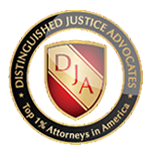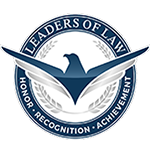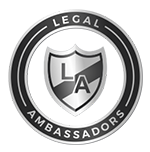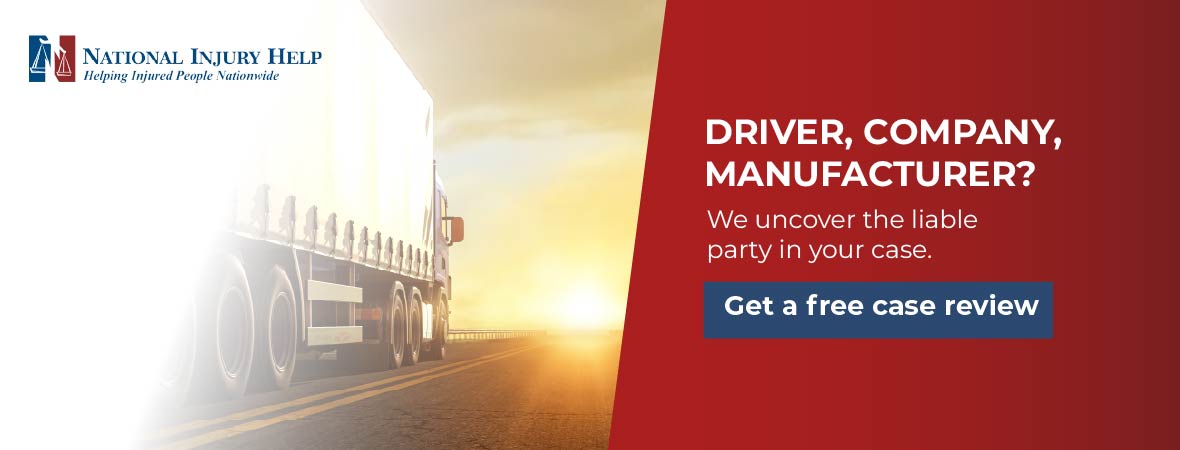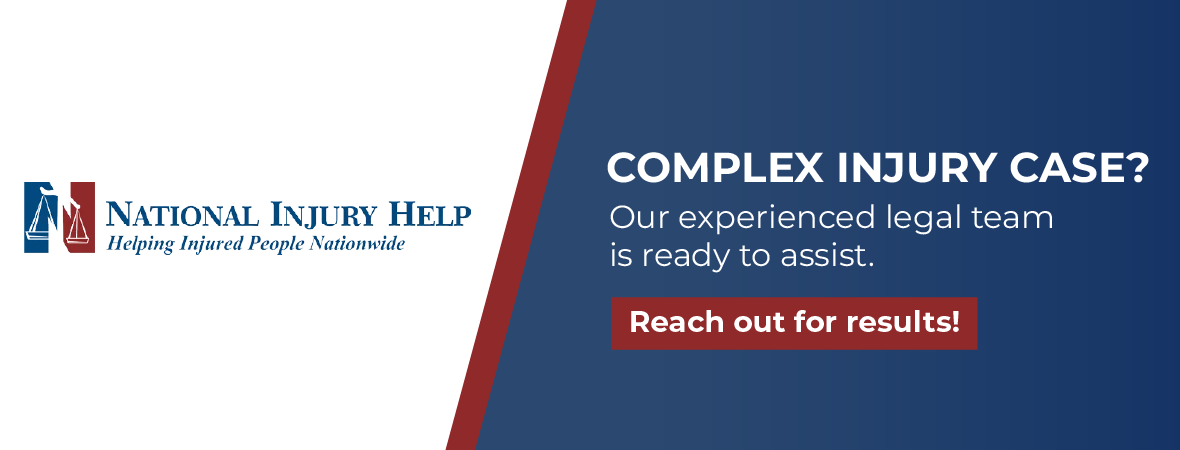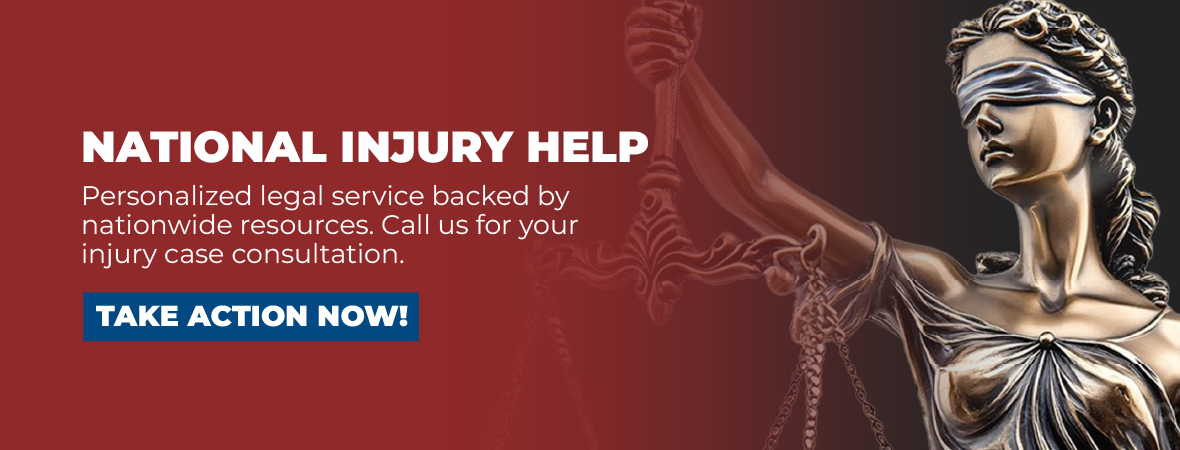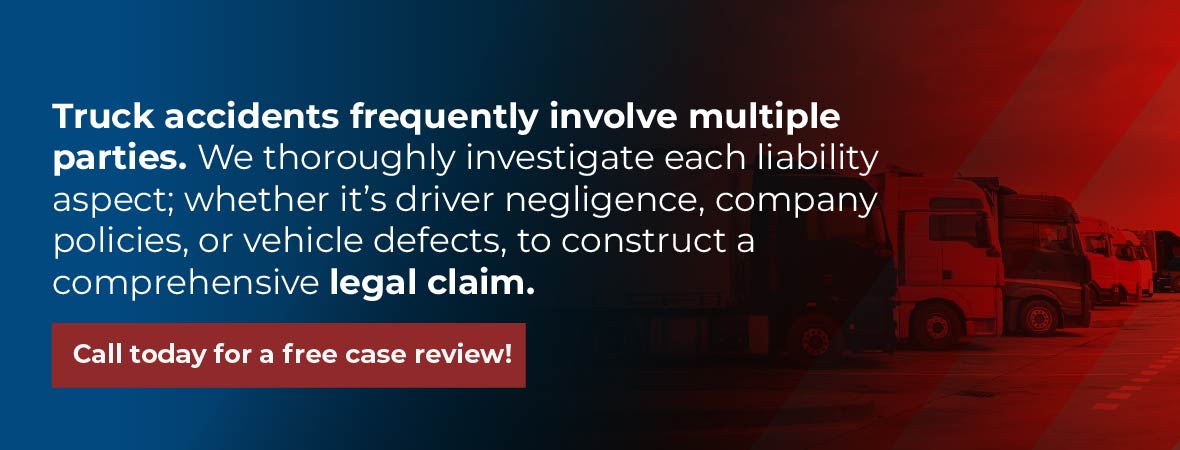After a truck accident, figuring out who is legally responsible can be complicated. If you were hurt in a commercial truck crash, contact National Injury Help by calling 1 (800) 214-1010. We will investigate your case and fight for the compensation you deserve.
From the busy lanes of I-95 on the East Coast to the vast stretches of I-5 out West, long-haul trucks keep the country moving. These massive vehicles carry everything from fresh produce and construction materials to household goods, logging millions of miles each day to keep shelves stocked and industries running.
But when a tractor-trailer crashes into a passenger vehicle, the results can be devastating. The size and weight of a big rig often leave smaller cars crushed and lives changed in an instant. And while the accident itself is traumatic, what comes next can be just as overwhelming. Figuring out who is responsible for medical bills, lost wages, and other damages isn’t always straightforward.
Unlike a typical car accident, where two drivers and their insurance companies are usually the only parties involved, a truck crash is far more complex. Responsibility might fall on multiple people or businesses, the driver behind the wheel, the trucking company that pushed an unrealistic schedule, a repair shop that overlooked a critical fix, or even the manufacturer of a faulty part.
What is Truck Accident Liability?
Liability means legal responsibility. If your carelessness hurts someone, the law can make you pay for medical bills, lost income, pain, and other losses. Truck accident cases rely on negligence, a formal word for failing to use reasonable caution.
How Negligence Is Proven
- Duty: Every truck driver, carrier, and mechanic must act with reasonable care.
- Breach: Someone breaks that duty by speeding, skipping maintenance, or loading cargo poorly.
- Causation: The breach directly causes injury.
- Damages: The injured person can show medical costs, lost pay, or property damage.
Fault Rules Vary by State
The United States does not use one nationwide formula for sharing fault, so where the lawsuit is filed matters.
- Pure comparative fault: A few states, such as California and New York, let you collect even if you are 99 percent to blame, though your award is reduced by your share of fault.
- Modified comparative fault: Most states bar recovery once you reach 50 or 51 percent fault.
- Contributory negligence: Four states plus the District of Columbia still follow an older rule that blocks recovery if you are even 1 percent at fault.
Knowing which system applies helps set a realistic strategy from day one.
Who is at Fault in a Truck Crash?
Truck accidents are rarely simple. Unlike a typical car crash, where it’s often one driver versus another, truck collisions can involve several parties, each with different roles, and different types of insurance. Here’s a breakdown of the main players who might share fault and why it matters:
- The Truck Driver
The most obvious person involved is the driver of the truck. They may be at fault for speeding, tailgating, driving while distracted, drowsy, or even under the influence.
It’s important to note that the legal blood alcohol content (BAC) limit for commercial drivers is just 0.04, which is lower than for regular drivers.
While the driver might have personal liability, their insurance coverage is often too small to cover the full extent of injuries in a major crash. However, proving driver negligence can open the door to larger corporate policies carried by their employer.
- The Trucking Company Responsibility (Motor Carrier)
Trucking companies are responsible for more than just dispatching drivers. They are required to properly train their employees, ensure vehicles are well-maintained, and schedule routes that don’t push drivers past legal limits.
If a company cuts corners or ignores red flags, it can be held directly accountable. Federal regulations make many of these duties “non-delegable,” meaning the company can’t avoid responsibility just because someone else was behind the wheel.
- Freight Brokers, Shippers, or Third-Party Logistics Providers (3PLs)
Sometimes the companies that arrange shipments contribute to the danger. They may overload trailers, fail to secure cargo properly, or pressure carriers to rush delivery.
These intermediaries often carry their own insurance policies, which can provide extra coverage in serious injury cases.
- Maintenance Providers or Mechanics
If a repair shop skips critical safety checks, installs the wrong parts, or signs off on faulty inspections, they can be held liable for negligent maintenance.
A poorly maintained truck is a danger to everyone on the road, and proving a mechanical failure can expand the scope of responsibility beyond just the driver and carrier.
- Parts or Vehicle Manufacturers
Defective equipment, such as tires, brakes, or trailer hitches, can also lead to disaster. If a product failure contributed to the crash, victims may be able to file a product liability claim against the manufacturer, distributor, or retailer responsible for putting that part into circulation. - Government Agencies
In some cases, the road itself is part of the problem. If a poorly designed curve, a broken traffic signal, or overgrown vegetation contributed to the crash, the agency responsible for road maintenance could be liable. These claims follow different rules and often involve very short filing deadlines, sometimes as little as six months, so acting quickly is crucial.
Common Mistakes That Cause Crashes
Here are some common mistakes that can cause a truck accident:
- Speeding: A fully loaded truck at 65 miles per hour needs two football fields to stop.
- Distracted driving: Texting is banned, yet hands-free calls, GPS fiddling, and even unwrapping lunch steal vital seconds.
- Fatigue: Federal hours-of-service rules cap driving to 11 hours after 10 hours off duty, but falsified logs still happen. A momentary micro-sleep can send eighty thousand pounds careening across lanes.
- Poor cargo securement: Shifting steel coils or tilting lumber raises the center of gravity and leads to rollovers.
- Deferred maintenance: Worn brake linings and cracked air hoses hide beneath the trailer, ready to fail on a downhill grade.
How Fault Is Divided
Liability is like slicing a pie. Each person or company gets a percentage. Investigators and lawyers decide who owns which slice using:
- Police reports for initial observations.
- Physical evidence, such as skid marks and debris.
- Electronic data from engine control modules and electronic logging devices. Many delete data every thirty days, so time is critical.
- Witness statements from other drivers, first responders, or nearby workers.
- Company documents, such as dispatch notes and maintenance logs.
- Expert analysis that converts raw data into clear explanations for judges and juries.
Every piece of proof slots into state negligence rules and federal safety standards, building a picture of responsibility.
Why Your Conduct Still Matters in a Truck Accident Case
Even if a truck roared through a red light, the defense will dig hard for anything that shifts blame onto you: driving a few miles over the limit, braking late, or having worn tires. Under comparative-fault rules, each percentage of blame assigned to you reduces your final check.
Imagine a jury finds your losses are worth six hundred thousand dollars. They decide the truck driver is eighty percent at fault, and you are twenty percent. You receive four hundred eighty thousand dollars, not the full six hundred.
In states with a fifty-percent bar, tipping over the halfway mark can erase your right to any money at all. That is why early evidence gathering and expert testimony are vital to keep your share of blame low.
Key Evidence You Need to Prove Liability in a Truck Accident Case
Building a strong truck accident case depends on collecting the right evidence, and quickly. Trucking companies often have access to data and records that can reveal what really happened in the moments leading up to the crash.
But that information can disappear fast unless you act quickly and know what to ask for. Here’s a breakdown of the most important types of evidence and why they matter.
Electronic Logging Device (ELD) and Engine Control Module Data
Modern trucks are equipped with devices that record key details like speed, braking patterns, engine performance, and driver hours. This data can show whether the driver was speeding, working too many hours, or failed to slow down before the impact.
To protect this data, a written spoliation letter should be sent to the trucking company as soon as possible, instructing them not to delete or overwrite the raw information.
Maintenance and Repair Records
If the truck had worn-out brakes, bald tires, or overdue service, those details can point to negligence. Maintenance logs and shop invoices help show whether required inspections were skipped or delayed. Legal teams can subpoena these documents and compare them to industry-required inspection schedules to build a case.
Cargo and Load Documents
Improperly loaded or unsecured cargo can easily shift during transit and cause a truck to lose control.
Bills of lading, weight tickets, and load securement photos help trace who handled the freight and whether mistakes were made during loading. These records often lead to freight brokers or shippers who may share responsibility.
Dash Camera Footage
Many trucks have forward-facing or driver-facing cameras that capture important footage before and during a crash. This video can show lane drifting, sudden swerving, or visual obstructions like blocked road signs. Because some systems automatically delete recordings after a few days, it’s critical to request copies as soon as possible.
Toxicology Reports
If there’s any suspicion the driver was under the influence, blood test results can reveal alcohol, stimulants, or other drugs in their system. These results, along with documentation showing the chain of custody from the lab, are vital in proving impaired driving.
Crash Scene Photos and 3-D Scans
Images of the scene can reveal skid marks, vehicle positions, gouges in the pavement, and the depth of vehicle damage. These details help accident reconstruction experts understand how the collision happened. Since vehicles are often towed and scrapped shortly after a crash, hiring an expert quickly is essential to preserve this physical evidence.
Contact a Truck Accident Lawyer Today
If a crash with a semi-truck has turned your life upside down, whether on the I-10, the I-17, or any road in between, you shouldn’t have to face the aftermath alone. Trucking companies act fast after a wreck, sending their own teams to protect their interests. You deserve someone in your corner doing the same for you.
At National Injury Help, we’re here to level the playing field. Call us at 1 (800) 214-1010 for a free consultation with no pressure and no obligation. We’ll work to secure critical evidence, dig into every available insurance policy, and stand up for your rights from start to finish. Let us take on the legal battle so you can focus on healing.

